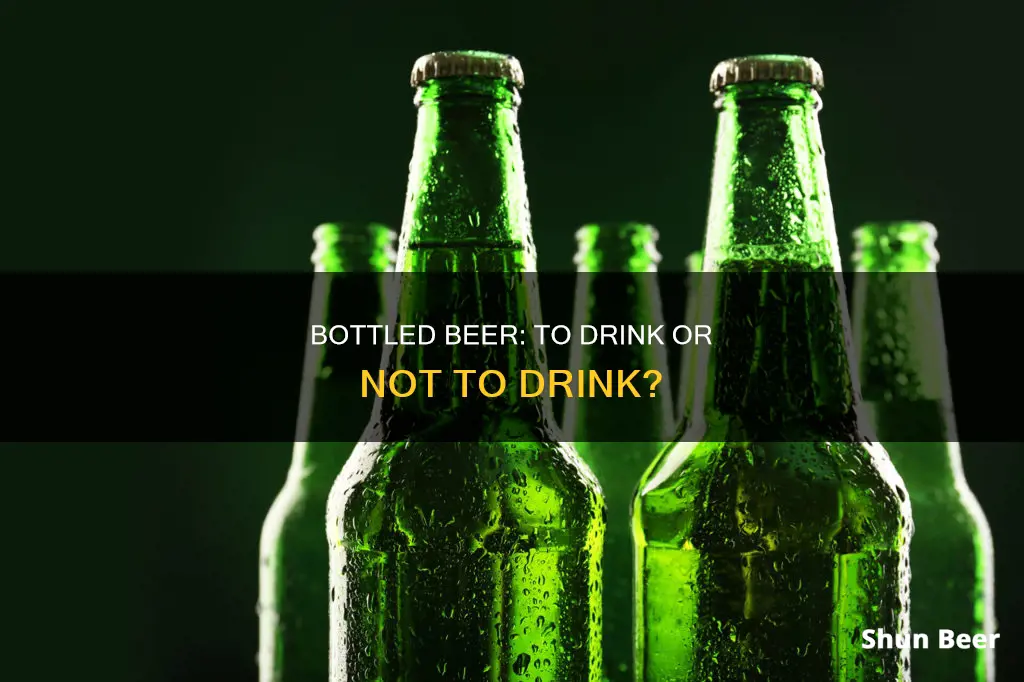
Drinking beer is a common pastime for many people, and there are several ways to do so. The most popular methods are drinking from a bottle, a can, or a glass. Each method has its own advantages and disadvantages, and the choice ultimately comes down to personal preference. Drinking beer from the bottle is a popular option due to its convenience and ability to keep the beer fresh and carbonated. However, it can be challenging to hold a bottle, and the narrow opening can limit the ability to appreciate the aroma and flavour fully.
What You'll Learn
- Drinking beer from a bottle is convenient and keeps it fresh and carbonated
- Bottles are portable and easy to hold, but can be slippery when cold and wet
- Drinking from a bottle may impact the taste and aroma due to the narrow opening
- Beer in a glass allows for better appreciation of colour, clarity, aroma and flavour
- Beer tastes best when stored in a cool, dark place and sealed after opening

Drinking beer from a bottle is convenient and keeps it fresh and carbonated
Drinking beer from a bottle is a popular choice for many beer enthusiasts. This method offers both convenience and certain advantages for maintaining the freshness and carbonation of the beverage.
One of the key benefits of drinking beer from a bottle is its portability. Bottles are easy to carry and can be taken on the go, making them perfect for outdoor activities, such as a backyard barbecue or a picnic. They fit comfortably in your hands and are less fragile than glasses, reducing the risk of breakage during transportation.
Another significant advantage of bottles is their ability to preserve the freshness and carbonation of the beer. The seal of a bottle helps keep the beer fresh and carbonated, which is crucial for highly carbonated beers like Belgian-style ales or pilsners. This seal prevents the beer from going flat, ensuring that you enjoy the full flavour and carbonation intended by the brewer.
Additionally, drinking beer from the bottle can extend its shelf life. Beer is highly susceptible to oxidation, which can cause it to lose its flavour and freshness. The seal of a bottle helps slow down the oxidation process, especially when the beer is properly chilled, thus prolonging its shelf life.
While drinking beer from a bottle has its benefits, it's important to consider some limitations. One drawback is the difficulty in fully appreciating the aroma and flavour of the beer due to the narrow opening of the bottle, which restricts airflow and can impact the overall sensory experience.
In conclusion, drinking beer from a bottle is a convenient and practical choice, especially when you're on the move or prioritising freshness and carbonation retention. However, for a more comprehensive sensory experience, you may consider pouring the beer into a glass to fully savour its colour, clarity, aroma, and flavour. Ultimately, the choice between bottle and glass depends on your personal preference and the specific characteristics of the beer you're enjoying.
Kayaking and Beer: Is It Safe to Drink and Paddle?
You may want to see also

Bottles are portable and easy to hold, but can be slippery when cold and wet
Drinking beer from a bottle is a popular choice for many beer drinkers. One of the main advantages is portability; bottles are easy to hold, fit perfectly in your hand, and can be taken on the go. They are a great option for a backyard BBQ or outdoor activities. Bottles also provide a seal that keeps the beer fresh and carbonated, which is crucial for highly carbonated beers.
However, one of the drawbacks of drinking from a bottle is that it can be slippery and difficult to hold, especially when it's cold and wet. This can lead to a messy situation if you're not careful. Additionally, the narrow opening of the bottle restricts airflow, which can impact the overall taste and aroma of the beer. You may not get the full sensory experience of the beer's colour, clarity, aroma, and flavour when drinking from a bottle.
To overcome the issue of slipperiness, some bottles have textured surfaces or grips, which provide a better hold. Another solution is to use a bottle insulator or koozie, which not only helps with grip but also keeps the bottle colder for longer. These accessories are especially useful during hot summer days or outdoor activities.
In conclusion, while bottles offer portability and convenience, they may not provide the optimal sensory experience for beer enthusiasts. The slipperiness of cold, wet bottles is a common issue, but it can be mitigated with thoughtful design or the use of accessories. Ultimately, the choice between drinking beer from a bottle, can, or glass comes down to personal preference and the specific context of consumption.
Root Beer's Soft Drink Status: What's the Verdict?
You may want to see also

Drinking from a bottle may impact the taste and aroma due to the narrow opening
Drinking beer from its bottle impacts the taste and aroma due to the narrow opening. The narrow opening of the bottle restricts the flow of air into the container, which can affect the overall taste and aroma of the beer. This is because the aroma of the beer is an important part of the drinking experience, and the narrow bottle opening can hinder the release of these aromatic compounds. The narrow opening can also affect the carbonation of the beer, which can further impact the taste and mouthfeel.
Additionally, drinking beer from a bottle can limit your ability to appreciate the full range of flavours and aromas that the beer has to offer. This is because the narrow opening restricts the amount of air that comes into contact with the beer, which can affect the release of volatile compounds that contribute to the beer's aroma and flavour. The shape of the bottle can also impact the way the beer flows, which can affect the release of these compounds.
The bottle's narrow opening can also affect the head of the beer. The head is the foamy layer that forms on top of the beer when it is poured, and it is an important part of the drinking experience. The narrow opening of the bottle can cause the head to be too small or too large, affecting the overall taste and mouthfeel of the beer.
Furthermore, the narrow opening of the bottle can make it difficult to control the flow of beer when pouring, which can lead to overflow and spillage. This can not only waste beer but also affect the carbonation and flavour of the beer as it interacts with the air.
Overall, while drinking beer from a bottle is a convenient and popular choice, it is important to consider how the narrow opening can impact the taste and aroma of the beer. For a more optimal drinking experience, it is recommended to pour the beer into a glass to fully appreciate its colour, clarity, aroma, and flavour.
PRP Recovery: Can You Drink Beer Post-Procedure?
You may want to see also

Beer in a glass allows for better appreciation of colour, clarity, aroma and flavour
Drinking beer from a glass allows for a fuller sensory experience of the beverage. The colour, clarity, aroma, and flavour of the beer can be appreciated more when it is served in a glass.
The colour of a beer can vary from pale straw to deep brown and even black, and viewing the beer in a glass allows one to appreciate the full spectrum of colours. The clarity of the beer can also be observed, with some beers having a crystal-clear appearance, while others may be hazy or cloudy.
The aroma of the beer is also better experienced when it is served in a glass. The narrow opening of a bottle restricts the flow of air, impacting the overall aroma of the beer. By pouring the beer into a glass, the drinker can better experience the complex blend of scents that contribute to the overall flavour profile.
Furthermore, drinking beer from a glass allows for better appreciation of the flavour. The shape of the glass can impact the overall taste, depending on the specific style of beer. Different types of glasses, such as tulip glasses or pint glasses, are designed to enhance the flavour and aroma of different beer styles.
In addition, the temperature of the beer can be controlled more effectively when it is served in a glass. Beer is sensitive to temperature changes, and drinking it from a glass allows the drinker to ensure that it is at the optimal temperature for their preference.
While drinking beer from a bottle or can has its advantages, such as portability and convenience, serving beer in a glass allows for a more comprehensive sensory experience, encompassing colour, clarity, aroma, and flavour. Ultimately, the choice of how to drink beer depends on personal preference, and there is no wrong way to enjoy a cold, refreshing beer.
Beer and Suboxone: Is It Safe to Drink?
You may want to see also

Beer tastes best when stored in a cool, dark place and sealed after opening
Beer is best stored in a cool, dark place, such as a refrigerator, and sealed after opening to maintain its freshness and quality. This is because beer is susceptible to spoilage from oxidation, light, and bacteria.
When exposed to oxygen, beer undergoes an oxidation process that causes it to lose its flavour and quality over time. Storing beer in a cool, dark place helps to slow down the oxidation process and maintain its freshness. Additionally, beer is sensitive to light exposure, especially UV light, which can alter its flavour and cause it to become "skunked." By storing it in a dark place, you prevent this undesirable flavour change.
Sealing the bottle or can tightly after opening is crucial to prevent oxygen from entering and spoiling the beer. This simple step can make a significant difference in preserving the beer's freshness and extending its shelf life.
The temperature of the storage location is also essential. Beer should be kept cool, as higher temperatures accelerate the oxidation process, leading to faster flavour loss and potential spoilage. Refrigeration helps maintain the ideal temperature, slowing down oxidation and keeping the beer fresh for a more extended period.
In addition to temperature and light control, it is essential to seal the beer container properly to prevent bacterial contamination. Beer provides an ideal environment for bacteria and microorganisms to thrive due to its various carbohydrates and proteins. By sealing the container and storing it in a cool, dark place, you create unfavourable conditions for bacterial growth, thus preserving the quality and safety of the beer.
Overall, storing beer in a cool, dark place and sealing it properly after opening are critical steps to ensure the beer remains fresh, maintains its flavour, and extends its shelf life. These simple measures can make a significant difference in enjoying your beer to the fullest.
Beer and Dark Stool: Is There a Link?
You may want to see also
Frequently asked questions
Yes, it is perfectly okay to drink beer straight from the bottle. Drinking beer from a bottle is a popular choice for many beer drinkers. The bottle keeps the beer fresh and carbonated, and it is easy to take on the go. However, drinking from a bottle can make it harder to appreciate the aroma and flavour of the beer due to the narrow opening.
Yes, the bottle you drink beer from can affect the taste. Clear or light-coloured bottles can make beer go skunky due to light exposure, which speeds up oxidation. Dark bottles offer better protection, and cans offer the most protection from light, preserving the beer's quality for longer.
Drinking beer from a bottle is more convenient than drinking from a glass in some situations. Bottles are portable, easy to hold, and can be taken on the go. Glasses, on the other hand, can be fragile and difficult to transport, making them less suitable for outdoor activities.
It depends on the establishment. Some restaurants and bars may prefer that you drink from a glass, especially if they offer specific types of beer glasses to enhance the drinking experience. However, there is no universal rule prohibiting drinking from the bottle, so it may be allowed in some places.
Drinking beer straight from the bottle does not pose any significant health risks beyond the general health considerations associated with alcohol consumption. However, it is important to note that sharing bottles can increase the risk of spreading germs and bacteria.







